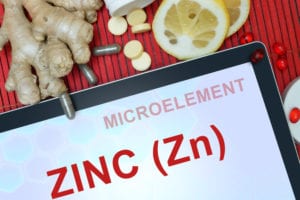Written by Taylor Woosley, Staff Writer. Results from this observational prospective study using 123 adult COVID-19 patients and 48 controls shows that a moderately negative correlation was observed between serum zinc levels and the severity of COVID-19 infection.
 The ongoing coronavirus disease (COVID-19) pandemic caused by severe acute respiratory syndrome coronavirus 2 (SARS-CoV-2) poses a severe threat to human health1. Spike glycoprotein on the surface of the COVID-19 binds to angiotensin-converting enzyme 2 (ACE2) receptor protein located on the host cell plasma membrane and facilitates the host cell invasion2. Exposure to the virus may result in asymptomatic infection or development of symptoms that range from mild upper respiratory symptoms to severe pneumonia with respiratory failure, hypercoagulation, and hyperinflammatory manifestations3.
The ongoing coronavirus disease (COVID-19) pandemic caused by severe acute respiratory syndrome coronavirus 2 (SARS-CoV-2) poses a severe threat to human health1. Spike glycoprotein on the surface of the COVID-19 binds to angiotensin-converting enzyme 2 (ACE2) receptor protein located on the host cell plasma membrane and facilitates the host cell invasion2. Exposure to the virus may result in asymptomatic infection or development of symptoms that range from mild upper respiratory symptoms to severe pneumonia with respiratory failure, hypercoagulation, and hyperinflammatory manifestations3.
Zinc is a key trace mineral involved in many biological processes including immunity and it is vital in both the innate and acquired responses to viral infections4. Studies have shown that around 10% of our body proteins utilize zinc and that it is a cofactor in at least 200 immunomodulatory and antioxidant reactions5. Zinc is important for gene regulation of lymphocytes, and for normal development and function of cells mediating nonspecific immunity such as neutrophils and natural killer cells6.
Almasaud et al. conducted an observational prospective study to analyze the association between serum zinc and inflammatory markers with severity of COVID-19 infection in adult patients. Subject inclusion consisted of being diagnosed with COVID-19 and being 18 years or older. Subjects (n=123) were characterized into four groups based on the severity of the infection. Blood samples were obtained, and serum zinc levels were measured using inductively coupled plasma-mass spectrometry. Procalcitonin (PCT) and ferritin levels were determined using chemiluminescent microplate immunoassay kit. LDH levels were obtained using kinetic colorimetric method kit.
Nominal data was analyzed using chi-square test. Correlation was analyzed by Pearson correlation analysis. Statistical analysis of differences between two groups was performed using two-tailed Student’s t-test with a confidence level of 95%. A total of 123 adult COVID-19 patients and 48 controls were enrolled. The comparative analysis of COVID-19 patients and controls showed a median age of 59.0 years versus 33.0 years. COVID-19 subjects had significantly lower zinc levels of 8.8 ± 2.3 µmol/L in comparison to the controls at 11.9 ± 1.8 µmol/L. Of the 123 subjects, 42 patients (34%) had mild symptoms, 41 patients (33.5%) were classified as moderate, and 40 (32.5%) were severe. Significant findings of the study are as follows:
- Serum zinc levels showed a moderately significant negative correlation with the severity of COVID-19 infection (r = -0.584).
- WBC (r = 0.461), CRP (r = 0.608), PCT (r=0.253), LDH (r = 0.496), and ferritin (r = 0.382) showed a moderate positive correlation with the severity of COVID-19 infection.
- The weak association of serum zinc with the severity of COVID-19 infection remained significant after adjusting for age (r = -0.361, p = 0.000). Similarly, the positive association of WBC (r = 0.281, p = 0.000), CRP (r = 0.442, p = 0.000) and ferritin (r = 0.181, p = 0.018) with COVID-19 severity remained significant after adjusting for age.
Results of the study show that a positive correlation was observed between the inflammatory markers of WBC, CRP, PCT, and LDH and the severity of COVID-19 infection. Additionally, data shows that patients with moderate and severe COVID-19 infection had lower serum zinc levels. Study limitations include the lack of data regarding other comorbidities which meant they were unable to adjust for these parameters during analysis.
Source: Almasaud, Abdulaziz Saad, Jamal Chalabi, Abdulmajid Al Arfaj, Ali Al Qarni, Ammar Alkroud, Zuheb Nagoor, Sana Akhtar, and Jahangir Iqbal. “Association of Serum Zinc and Inflammatory Markers with the Severity of COVID-19 Infection in Adult Patients.” Nutrients 15, no. 2 (2023): 340.
© 2023 by the authors. Licensee MDPI, Basel, Switzerland. This article is an open access article distributed under the terms and conditions of the Creative Commons Attribution (CC BY) license (https://creativecommons.org/licenses/by/4.0/).
Click here to read the full text study.
Posted March 1, 2023.
Taylor Woosley studied biology at Purdue University before becoming a 2016 graduate of Columbia College Chicago with a major in Writing. She currently resides in Glen Ellyn, IL.
References:
- Qasem A, Shaw AM, Elkamel E, Naser SA. Coronavirus Disease 2019 (COVID-19) Diagnostic Tools: A Focus on Detection Technologies and Limitations. Curr Issues Mol Biol. Jul 20 2021;43(2):728-748. doi:10.3390/cimb43020053
- Majumder J, Minko T. Recent Developments on Therapeutic and Diagnostic Approaches for COVID-19. Aaps j. Jan 5 2021;23(1):14. doi:10.1208/s12248-020-00532-2
- Ciotti M, Benedetti F, Zella D, Angeletti S, Ciccozzi M, Bernardini S. SARS-CoV-2 Infection and the COVID-19 Pandemic Emergency: The Importance of Diagnostic Methods. Chemotherapy. 2021;66(1-2):17-23. doi:10.1159/000515343
- Shakoor H, Feehan J, Al Dhaheri AS, et al. Immune-boosting role of vitamins D, C, E, zinc, selenium and omega-3 fatty acids: Could they help against COVID-19? Maturitas. Jan 2021;143:1-9. doi:10.1016/j.maturitas.2020.08.003
- Jothimani D, Kailasam E, Danielraj S, et al. COVID-19: Poor outcomes in patients with zinc deficiency. Int J Infect Dis. Nov 2020;100:343-349. doi:10.1016/j.ijid.2020.09.014
- Joachimiak MP. Zinc against COVID-19? Symptom surveillance and deficiency risk groups. PLoS Negl Trop Dis. Jan 2021;15(1):e0008895. doi:10.1371/journal.pntd.0008895
